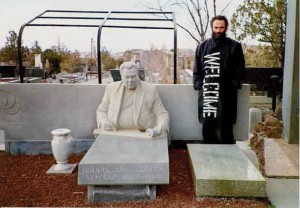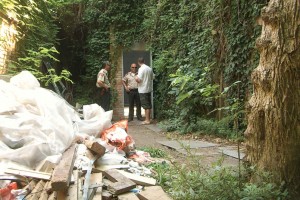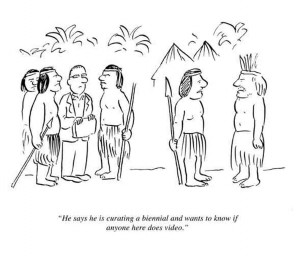« Features
PUSH TO FLUSH / The Advent of Neo-Modernity
There is an esprit d’époque called “neo-modern” which has been manifesting itself in realms as disparate as the visual arts, architecture, religion, economics, politics, and philosophy. It’s not new; it goes back to the 1980s, and although the concept is not very innovative, its overwhelming presence in very different fields makes its codification inevitable and inalienable. Let’s consider it in more detail. 1
By Paco Barragán
This return or ricorso to the modern invades certain knowledge of our contemporaneity and permits the establishment of more or less probable connections. It overlaps partly with post-modernity, but it lacks a clear starting point, thus it is first necessary to delimit concepts like “modernity” and “modernism.”
For many European philosophers and scholars, modernity came into being with the Enlightenment and the rule of reason. Lucia Santaella, a Brazilian professor of semiotics, starts with the argument that “modernity goes back to the Renaissance… it began in the age of capitalism, the rise of modern philosophy and science, at the time when painting became portable and music left the churches.”2 Indeed, modernity and its diverse avant-gardes signify a series of European movements, philosophies, and cultural changes.

Azat Sargsyan, performance Welcome to Armenia, the Museum under the Heaven, 2008, Giumry Biennial of Contemporaty Art , 2008. Courtesy the artist
Nowadays, “issues of modernity are invariably linked to globalization,” says Andreas Huyssen, and “the geographic opening of the question of other modernisms and alternative modernities across the world - modernism in other worlds as a mutant global reality rather than something limited to the Northern Transatlantic.” (307) Huyssen poses the pertinent question: “what do we make of the return of ‘modernity’ in contemporary discussions of globalization?” (307)
The Brazilian philosopher Sergio Rouanet was already using the term neo-modern in 1987, in his book, As Razoes do Iluminismo, in which he states that modernity has led the “neo-modern” project to be defined as “neo-liberal.” (269-70)
“What is neo-modern? Neo-modern means searching in the archives of modernity for the authentic sense of modernity; it means contesting the current modernity in the name of virtual modernity; it means requiring from all postmodern visions an inflexibly modern program as the only way to concretize hopes (interrupted partial or betrayed) consolidated on the project of modernity.”(269-70)
NEGATIVE AND POSITIVE NEO-MODERNITY
All of this was confirmed some years later with the defeat of Communism, and November 12, 1989, can be cited as the start of the first negative neo-modernity within which neo-conservatism and neo-liberalism prevail as the political and economical philosophies commanded by Margaret Thatcher and Ronald Reagan. This negative neo-modernity, which entails a “negative adaptation” to tradition, coincides with the peak of post-modernity and its predilection for irrationalism, relativism, and discontinuity.
In the same year, Habermas developed a new paradigm to re-signify modernity against prevailing conservative post-modern impostures - in particular those of Lyotard - in his Critical Theory of Modernity. What led the modernity project to failure was a certain individualist, selfish reasoning that had made the subject dependent on the laws of the capitalist market and state bureaucracy. The communication between the “life world” and the “system world” had to be restored through true reason again.
In turn, sociologist Edward Tiryakian also stressed this neo-modern condition in 1991, in an article titled “Modernization: Exhumetur in pace”: “Neo-modernism will serve as a rough-and-ready characterization of this phase of post-modernization theory until a term appears that represents the new spirit of the times in a more imaginative way.” (165-80)

Santiago Sierra, Wall Enclosing a Space, 2003, Spanish Pavilion, Venice Biennale, Venice. Photo: Javier San Martin. Courtesy Ida Pisani di Prometeo Gallery, Milan.
The most palpable expression of this neo-conservative and neo-liberal failure is the terrorist attack on September 11, 2001, and the bankruptcy of Lehman Brothers (and subsequent world stock market collapse) on September 14, 2008, owing to toxic assets.
Although the enumeration of dates may seem monotonous, there is no doubt that November 4, 2008, will be less conventional, as it represents the election of Barack Obama to the presidency of the United States, with all its due symbolism. If we proceed with our speculations, we could argue that from this moment the world entered a positive neo-modernity, foreshadowing a “positive adaptation” to tradition, which leaves aside post-modernist maxims3 and regains certain modernist essences like the role of the state, redistribution politics, equality, social care, education, and environmental conscience.
NEO AS CRITICAL REFORMULATION OF THE PAST
“Neo” not only implies a mere repetition, recurrence, or recycling of certain modernisms, periods, and philosophies from the past, but a revision, revaluation, and, as a result, a critical reformulation of the past looking to the future. This is to a great extent logical, as nobody wants to place their faith in the pure future, given that most utopias have shown their complete impracticability. Whereas modernity yearned for the new as a way to utopia, and post-modernity recycled the old in its dystopia, neo-modernity explores new revitalising alternatives conscious of the modernist limitations associated with the demands of the new and the utopian. So, in our analysis, neo-modernity embodies an innovation that has shifted from a “negative” to a “positive” adaptation of tradition as seen in diverse models of modernity.
Modernism can be explained as the transition phase of the Western arts and architecture from modernity to post-modernity. Post-modernity involved eclecticism, the looting and mix of past techniques, styles, movements, and periods without any order or rank by means of “copy and paste” strategies, hyper-texts and hyper-images, and the “everything goes” attitude. Neo-modernity has not only embarked upon a re-reading of modernism, but also of other artistic movements, be it in a literal, formal, or conceptual manner. The difference now stems from the fact that only a certain period is being reinterpreted at the time, and not the appropriation of fragments from images or texts from different styles or times, which lead to an artistic practice created from remains or leftovers. In this sense, Eve Sussman’s video 89 Seconds at Alcazar (2004), in which she reconstructs the moments prior to the setting of the scene in Las Meninas, painted by Velázquez, could be considered symptomatic of this “techno-referential” esprit d’époque. Consider Foucault’s concept of “a representation of a representation” and the work of art as “episteme.”
In 1987, Omar Calabrese published his book L’età neobarroca (Neo-Baroque: A Sign of the Times) as a cultural phenomenon of the time characterized by a specific internal “form” that evoked the Baroque. More recently, Angela Ndalianis picked up the debate in her book Neo-Baroque Aesthetics and Contemporary Entertainment (2004) by referring to the Baroque as a possible frame for apprehending society and contemporary entertainment media. In the field of visual arts, Domus Artium (DA2), Salamanca’s contemporary art centre in Spain, opened in October, 2005, coinciding with the celebration of the 250th anniversary of the city’s Baroque main square, the exhibition Baroque and Neo-Baroque. The Hell of the Beautiful. Back in the early 1980s, the British music scene was dominated by New Romantics like Spandau Ballet and Duran Duran; and the Schirn Kunsthalle also participated in this “neo” revival in May, 2005, with the exhibition Ideal Worlds - New Romanticism in Contemporary Art, in which they reflected upon this rebirth of the romantic spirit in contemporary art practices.
In the philosophical field, military neo-liberalism violence and counter-violence - such as the neo-Leninist logic of Al Qaeda - brings Simon Critchley to propose the term neo-anarchism as a new policy of resistance, civil disobedience, and non-violence.(63-67) Neo-modernity manifests itself thus in the formation of a political subjectivity as an appeal to universality, whether a demand for political representation, equality of treatment or anything else. In business, we sense a neo-management philosophy based on “storytelling” and the attraction of change, as masterly unveiled by Luc Boltanski and Eve Chiapello in The New Spirit of Capitalism.4 Besides, neo-politics obliges those who want to achieve power to tell convincing stories about the nation, their problems, and, above all, about themselves, as has been the case with Obama.
To cut this omnipresent, overwhelming, but by no means homogenous, return to “neo” short, reference could be made to Pope John Paul II’s neo-ecumenism, taken up by Benedict XVI, and, continuing in the spiritual realm, the neo-conscience of spiritual leaders like Eckhart Tolle, Pema Chodron, or Acharya Yogeesh and their new interpretation of time and the now.
In brief, it may be affirmed that neo-modernity represents a search for an intermediate space in between modernity’s rationalism and post-modernity’s relativism. This reinvention of reason connects more with the positive message of Habermas than with the apocalyptic Lyotard and Baudrillard. From a negative neo-modernity we move into a period of positive neo-modernity, within which micro-utopias and progress will be possible and desirable, despite the deafening fall of ideologies and grand narratives. It will not entail a full return to them, but it will bring about a curious synthesis of modern assumptions under the conditions of global capitalism.
The art world and the art system, where biennials and art fairs have created a canon of global homogenization over the previous years, need to engage as well in the search for a meaningful intermediate space capable of contextualizing as yet unexplored hybrid options.
NEO-BIENNALISM AND NEO-FAIRISM
Having arrived at this point, we can now go to the heart of the matter: what should the task of a biennial or an art fair be in the early twenty-first century? In other words: how can we reformulate the functions of biennials and art fairs as institutions and artistic structures?
Before attempting an answer, let me first introduce some brief thoughts about the biennalization of the world. The ‘90s can be commonly considered “the age of the biennials,”5 and this decade as “the age of the art fair,” though this, I think, is coming to an end. To a greater or lesser degree, biennials have lost the significance they once had - that Buergel’s Documenta turned into a Wunderkammer and Storr´s Venice Biennale into a salon is a rather conservative and unexpected twist6 - but even so, they keep growing steadily.7
Now, when I think these days about biennials I can’t help but be reminded of Pablo Helguera’s “artoon” of the curator visiting a native village: “He says he is curating a biennial and wants to know if anyone here does video.” Maybe I would have chosen “installation” instead of “video,” as the high impact spectacular installation has become the commodified medium par excellence that embodies “biennial art” (in the same way that painting as the most saleable art form embodies “art fair art.”) Anyway, the parable is poignant, but it reflects the current situation with wit and intelligence. This brings us to the two basic types of biennial, which represent more or less the majority: 1) the universalist, international, gigantic, authorial, large budget biennial, and 2) the smaller in scale and budget, with a mix of blue chip international and local artists, more emerging or unstable proposals, centered on local/global discourses. These two types are also applicable to art fairs to a certain extent, where there is also an insistent trend towards “curated sections” and special artists’ solo presentations or group exhibitions specifically developed for the fair.
New Institutionalism re-used and renovated the strategies of institutional critique initiated by conceptual art. This allows us to trace an analogy and launch the idea of a “neo-biennalism” and a “neo-fairism”: a new way of understanding and reformulating the function of the biennial and the art fair as an institution and artistic structure. Some may argue that it is not appropriate to mix the two concepts, as biennials are intellectually legitimated and art fairs are not. I would remind them of Mexican international curator Cuauhtémoc Medina’s comments back in 2001: “Curatorship is a creative sublimation of forces such as: the quest for prestige of bourgeois patrons, the tickle of legitimacy and cultural disinfection of state bureaucracies, the search for new hegemonic powers of the old nationalisms, and the ardor of those two omnipresent erotic forces - vanity and greed.” (34)
As we have been speculating on neo-modernism, neo-biennalism, and neo-fairism, let me finish with a quote from the movie The Matrix, when Neo considers turning back, but Trinity forces the moment to its crisis: “You have been down there, Neo. You know that road. You know exactly where it ends, and I know that is not where you want to be.” Maybe we should choose the red pill to see how deep the art hole goes….
Notes
1 This is a part of a larger essay originally published as “Neo-modernity, Neo-biennalism, Neo-fairism” in 2000 and Beyond. Contemporary Tendencies. Ed. Valerio Terraroli, Volume 5 “Art of the Twentieth Century” series, Milan: SKIRA, 2010. 275-291.
2 See e-article http://www.pucsp.br/~lbraga/epap_cult6.htm (Portuguese version in Lucia Santaella, Cultura das Mídias, 2004, ed. Sao Paulo: Experimento, Sao Paulo).
3 Post-modernist values like pluralism and the respect shown towards others and minorities will be maintained.
4 See. Boltanski, Luc, and Eva Chiapello. The New Spirit of Capitalism. Trans. G. Elliot, London: Verso, 2006
5 Not only because of their importance to the artistic discourse, but also because of the growing number of biennials in non-mainstream countries during this decade: Sharjah Biennial, United Arab Emirates (1993), Gwangju, South Korea (1995), Johannesburg Biennale (1995), Shanghai Biennale, China (1996), Mercosur Biennial, Porto Alegre, Brazil (1997), Dak’art Biennale, Senegal (1998), Busan Biennale, Korea (1998); and in Europe the Berlin Biennale, Germany (1998).
6 See for example the interesting articles on this subject by Darío Corbeira’s “Documenta 12: Aladdin in Kassel” and Carlos Jiménez’s “Wunderkammer,” Brumaria 9 (2007), pp. 365-74.
7 I have to admit that I am a little bored now by the excess of biennials, especially as they do not add anything to the artistic discourse nor to the city they are held in, like the most recent Brussels Biennial. Now it seems that not only founding biennials, but also setting up conferences about biennials -whether a city has a biennial or not - is the trend. See for example e-flux titled “The Bergen Biennial Conference”, from the Kunsthall Bergen, dated February 24, 2009, and also “On biennials/Tutto sulle biennali”, dated March 17, 2009, at the Festival of Contemporary Art in Faenza. For both see www.e-flux.com .
WORKS CITED
Critchley, Simon. “On Neo-Anarchism.” Sustainabilities Ed. P. Barragán. Milan: Edizioni Charta, 2008. 63-67.
Huyssen, Andreas. “Modernity as Antiquity. A Category Mistake.” in Brumaria 9: Modernity? Life!, (2007): 307.
Medina, Cuauhtémoc. “Una teoría sobre la derrota.” Lápiz: Revista Internacional de Arte February 2001: 34-45.
Rouanet, Paulo Sergio. As razoes do Iluminismo. Sao Paulo: Companhia das Letras, 1987 pp. 269-70.
Tiryankian, Edward A. “Modernisation: Exhumetur in pace.” International Sociology 6 (1991), 165-80.



































